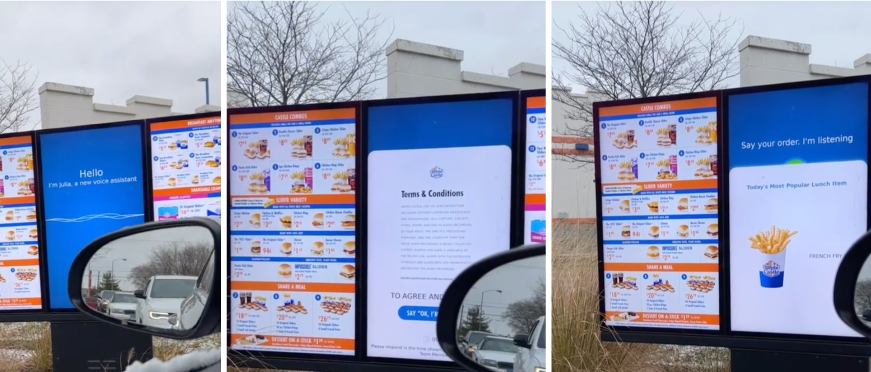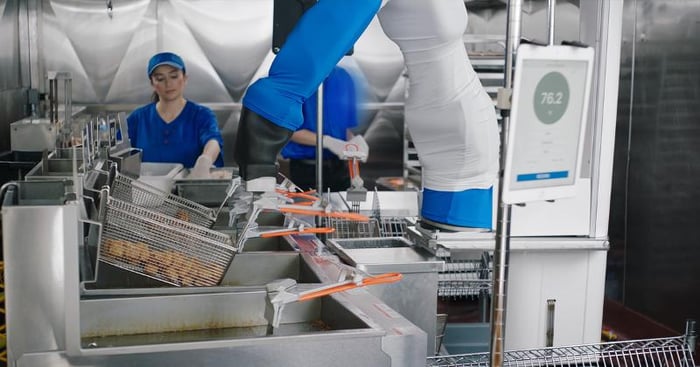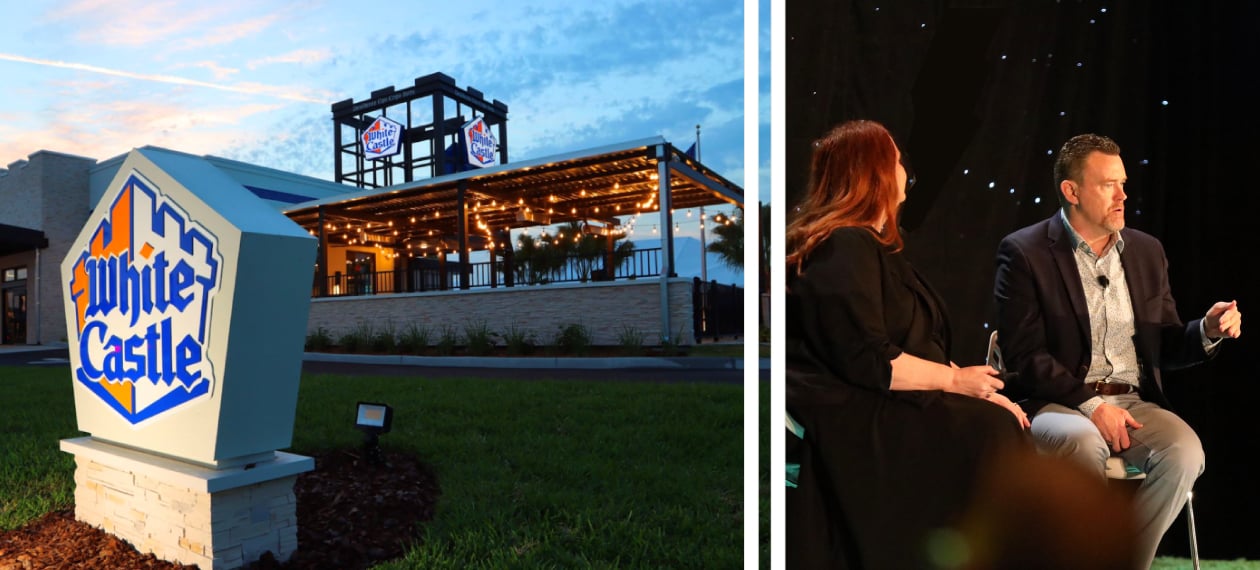White Castle may be more than a century old, but it’s leading the charge into the restaurant industry’s future. In recent years, the iconic hamburger chain has begun rolling out artificial intelligence and automation solutions, from burger-flipping robots to its own Alexa-like digital assistant. The technology fits into White Castle’s new mission to “create memorable moments every day,” giving its employees more freedom to deliver positive experiences for their guests.
In a recent conversation at RestaurantSpaces Fall in Santa Barbara, White Castle CIO Susan Carroll-Boser joined VP of Operations Services Mike Guinan to discuss the brand’s technological innovations and what AI means for restaurant operators everywhere.
"It's coming," Carroll-Boser said. "It's been coming for 15 to 20 years."
Introducing Julia
The centerpiece of White Castle’s automation strategy is Julia, the conversational AI powering its drive-thru in two locations (soon to be three). The product of a partnership with Mastercard beginning in 2020, Julia uses natural language processing technology to provide a frictionless drive-thru experience for customers while freeing up employees for more important work. In addition to providing a consistent customer experience, Julia is also designed to upsell, meaning it drives sales while mitigating labor bottlenecks.
"When we think about our drive-thru customer service specialist, that person has four to five jobs in most of our castles," Guinan explained. "We've just relieved that person from taking the order, which allows them to greet you at the window or the hospitality door and say, 'Your total is this. How are you today?' It allows that little interaction to create a memorable moment, which is what we strive to do.”
The technology comes with privacy and compliance concerns that the industry will have to figure out as it evolves, not to mention substantial infrastructure needs. "For anybody who's on the construction side in this room, I need lots of cabling," Carroll-Boser joked. "Please make huge conduits for us out to the drive-thru. We're very needy."

Conversational AI "Julia" in action at the drive-thru
How Flippy Fixes Fryer Woes
While Julia takes orders outside, Flippy makes them inside. The Miso Robotics-designed robot-on-a-rail uses computer vision and machine learning to identify White Castle’s eleven freezer-to-fryer menu items, pluck them out of a hopper or bin, cook them, and deliver the results to a human employee for packaging.
Like Julia, the technology frees up team members to deliver high-quality customer interactions; it also ensures consistent cook times, temperatures, and portions.
“Our fryer had become our bottleneck,” Carroll-Boser explained. “You had to be an octopus to run the fryer. Our value proposition was around taking care of a major bottleneck for speed of service, but also for team member satisfaction. It's a smarter freezer starting to do its own portion controlling for us. I just love the idea of our industry having portion control. Our team members do not like doing portion control.”
White Castle is currently developing technology to integrate Flippy into its POS platform, which will give it the ability to prepare and cook menu items based on sales data and the flow of business. "We do product projection now, but whether the people cook to the projection — especially when they're really busy — is always the hardest thing," Carroll-Boser said.

"Flippy" has become a BOH mainstay at White Castle restaurants
The Connected Restaurant
Flippy’s future reflects Carroll-Boser’s and Guinan’s vision for the future of White Castle — and the restaurant industry more broadly. Taking a cue from the manufacturing industry, their team is implementing Internet Of Things technology in all of its machines. The goal is to create safer, more connected restaurants, where everything from equipment downtime to lunch rushes are predictable and manageable.
“When we have a bottleneck — which a lot of times adds up in speed of service — we don't know if it's because they haven't set griddles [or] they ran out of capacity on the griddles they had,” Carroll-Boser said. “We know how many people are there, but we don't know what they're doing. Being able to understand more of what the equipment's doing is really important for the future.”
AI-powered restaurants will also be better equipped to identify and solve customer experience problems. Guinan offered drive-thru lines as an example: White Castle currently measures speed of service starting when a car crosses the loop detector, even though from the customer’s point of view, the experience begins when they pull into the drive-thru line. Computer vision technology can fix this asymmetry, helping operators reduce bottlenecks they may not even be measuring. “For us to have that knowledge, to truly understand how long customers are waiting — I know it'll help us make decisions differently,” Guinan said.
“Think of Your Buildings as a Highway”
Building the restaurant of the future won’t be easy. As Carroll-Boser and Guinan explained, automation brings its own panoply of design and construction challenges. Conversational AI technology has to account for noisy drive-thru conditions; computer vision has to account for, well, the inherent ugliness of camera arrays.
“We design our restaurants for beauty, not always for cameras hanging everywhere,” Carroll-Boser said. “We need beautiful ways to have cameras everywhere.”
Those are just the beginning. Consider the back-of-house, which is already meticulously designed to minimize movement throughout the kitchen. Introducing new technology — which by nature evolves and improves every few years — means that kitchen spaces will need to be adaptable enough to accommodate new equipment and accompanying operational changes.
“I need to be able to shift that hood three to six inches up, down or left to right,” Guinan said. “Which means HVAC needs that same flexibility and our counters need that same flexibility.”
Or consider connected AI devices, which require extensive cables and infrastructure flexible enough to accommodate them. "Please build me a web of walls that have cabling abilities everywhere," Carroll-Boser said. "Thinking about tunnels, web tunnels, things like that to actually allow the flexibility of your spaces to change. Not just the size but also the walls and the infrastructure. Think of your buildings as a highway on the outside with lots of infrastructure in the future."
These challenges may be daunting, but they likely pale in comparison to the challenges ahead for brands that don’t embrace the industry’s future. “If you are not already in robotics and you do agree that it's coming,” Guinan concluded, “I suggest you do it sooner than later.”

Posted by
Chain Restaurants Reimagined.
The Retreat to Reimagine Restaurant Development, Design + Technology.
April 12-14, 2026 | Miami, FL





-3.png)

-3.png)
-4.png)
-3.png)

Comments